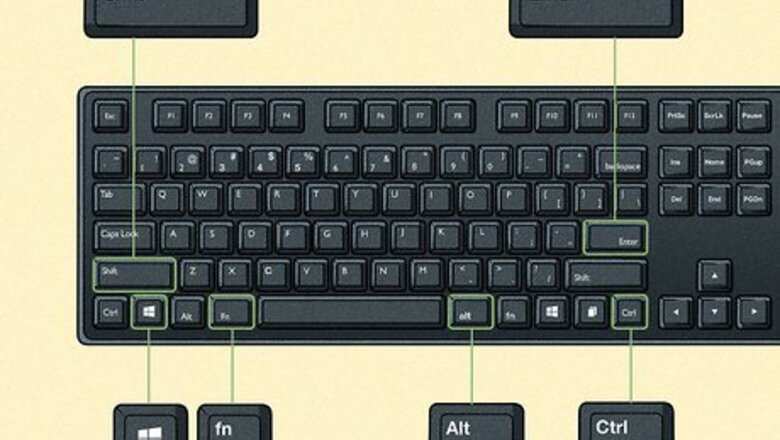
views
- To use a keyboard shortcut, you'll need to press one or more keys simultaneously.
- Many Windows shortcuts that involve the Ctrl key are similar on a Mac, except on a Mac, Ctrl is often replaced with Command.
- Keyboard shortcuts may have different behaviors in different apps.
Windows
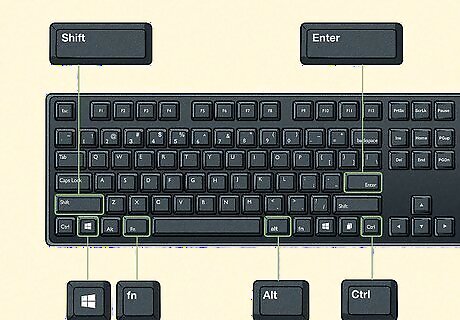
Understand how key shortcuts work. To use a key shortcut, you will hold down one or more modifier keys and press a letter (or another modifier key). Modifier keys include the following: Ctrl - Usually found on the left and right sides of the keyboard. The right Ctrl key will be just left of the arrow keys. Alt - Found on the left and right sides of the keyboard, farther in toward the center of the keyboard than Ctrl. ⇧ Shift - Symbolized by an upward-facing arrow, this key is on the left and right sides of the keyboard. Fn - The "function" key allows you to use secondary functions of other keys. Commands that use the function keys (e.g., F8) may require use of the Fn key. ⊞ Win - This key displays the Windows logo, and is normally in the bottom-left side of your keyboard. Arrow keys - While not technically modifier keys, the arrow keys can be used to select items. ↵ Enter - This key allows you to open a selected item. It's essentially a mouse left-click.
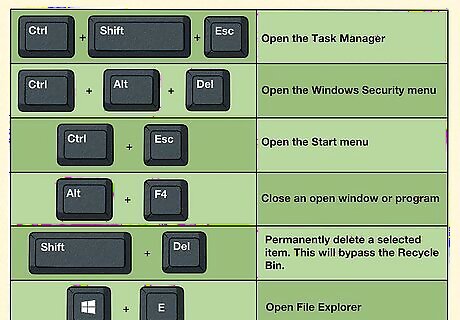
Use general key shortcuts to access Windows features. These combinations help you perform basic Windows tasks: F1 - Open the Help page. You must have Internet access for this. If your computer has an Fn key, you may need to hold it while pressing F1. ⇧ Shift+F10 - Bring up the context menu for a selected item. This is usually accomplished by right-clicking. Ctrl+⇧ Shift+Esc - Open the Task Manager. Ctrl+Alt+Del - Open the Windows Security menu. (works from XP to 10) Alt+Space - Bring up the current window's System menu, from which you can resize, minimize, maximize, or move the current window. Ctrl+Tab ↹ - Move through current window's tabs (e.g., in a browser). Ctrl+Esc - Open the Start menu. Alt+Tab ↹ - Switch between currently open windows, excluding the desktop. Alt+F4 - Close an open window or program. ⇧ Shift+Delete - Permanently delete a selected item. This will bypass the Recycle Bin, though you'll need to click OK to confirm. ⊞ Win - Open Start. ⊞ Win+L - Lock the computer. If your computer doesn't use a password, this will still take you to the user selection screen. ⊞ Win+R - Open the Run box. ⊞ Win+M - Minimize all open windows and display the desktop. ⇧ Shift+⊞ Win+M - Restore all minimized windows. ⊞ Win+E - Open File Explorer. ⊞ Win+Ctrl+F - Find another computer on your network (networked computers only). ⊞ Win+Tab ↹ - View all currently open Windows. ⊞ Win+⎊ Break - Open the System Properties window. ⊞ Win+⎙ PrtScr - Take a screenshot. Ctrl+F - Open a search bar to look for specific words or phrases on the page.
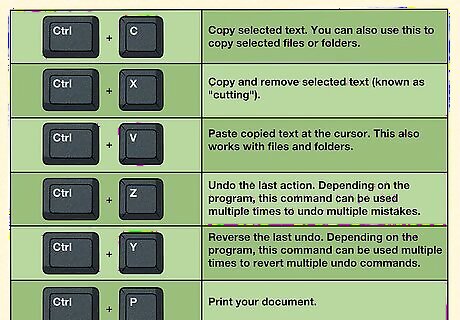
Use keyboard shortcuts to help with typing, copying, and pasting. There are several text-editing shortcuts in Windows that extend to most instances of typing, as well as file copying and pasting: Ctrl+C - Copy selected text. You can also use this to copy selected files or folders. Ctrl+X - Copy and remove selected text (known as "cutting"). Ctrl+V - Paste copied text at the cursor. This also works with files and folders. Ctrl+Z - Undo the last action. Depending on the program, this command can be used multiple times to undo multiple mistakes. Ctrl+Y - Reverse the last undo. Depending on the program, this command can be used multiple times to revert multiple undo commands. Ctrl+P - Print your document. Ctrl+S - Save your document. Ctrl+B - Bold the selected text. This will work in Microsoft Office products and most email providers. Ctrl+U - Underline the selected text. This will work in Microsoft Office products and most email providers. Ctrl+I - Italicize the selected text. This will work in Microsoft Office products and most email providers.
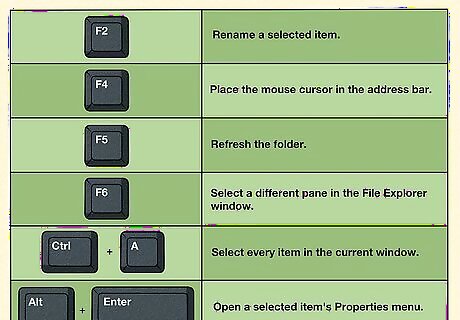
Use keyboard shortcuts in File Explorer. There are a few keyboard shortcuts you can use to navigate in the File Explorer: F2 - Rename a selected item. F4 - Places the mouse cursor in the address bar. F5 - Refreshes the folder. F6 - Selects a different pane in the File Explorer window. Ctrl+A - Selects every item in the current window. Alt+↵ Enter - Open a selected item's Properties menu.
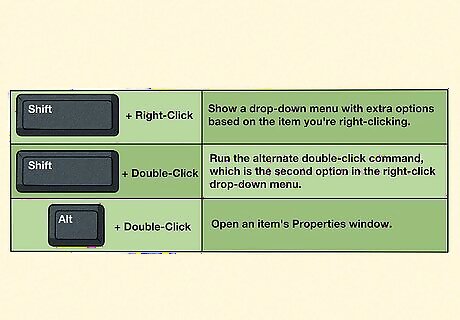
Use key shortcuts with the mouse. Most programs have an advanced menu that can be accessed using the mouse while pressing a key: ⇧ Shift + Right-Click - Shows a drop-down menu with extra options based on the item you're right-clicking. ⇧ Shift + Double-Click - Runs the alternate double-click command, which is the second option in the right-click drop-down menu. Alt + Double-Click - Open an item's Properties window.
Mac
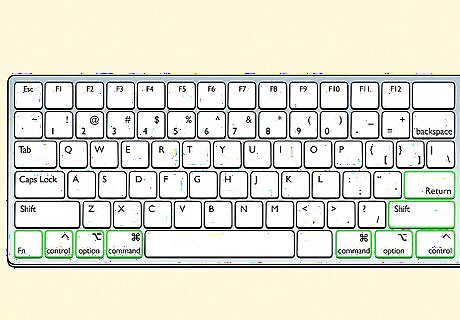
Understand how key shortcuts work. To use a key shortcut, you will hold down one or more modifier keys and press a letter (or another modifier key). Modifier keys include the following: ⌘ Command - Located on the left and right sides of the spacebar. ⌥ Option - Located next to the ⌘ Command keys. Control - Located on the left side of the keyboard. Fn - Located in the bottom-left side of the keyboard. This key activates the alternative uses for the "Function" keys (e.g., F8). ⇧ Shift - Located on the left and right sides of the keyboard. Arrow keys - While not technically modifier keys, the arrow keys can be used to select items. ⏎ Return - Located on the right side of the keyboard. Allows you to open a selected item.
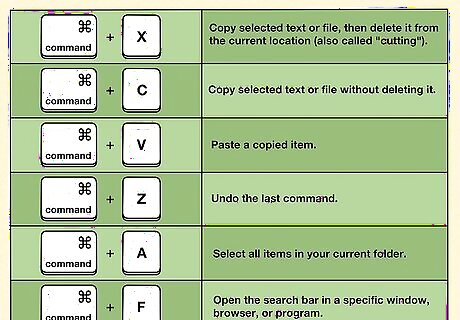
Use keyboard shortcuts for common actions. Instead of using the mouse or a program's buttons, you can use your Mac's keyboard to do things like copying files or text, and opening certain programs: ⌘ Command+X - Copy selected text or file, then delete it from the current location (also called "cutting"). ⌘ Command+C - Copy selected text or file without deleting it. ⌘ Command+V - Paste a copied item. ⌘ Command+Z - Undo the last command. ⌘ Command+⇧ Shift+Z - Redo the last command if you used the Undo command. ⌘ Command+A - Select all items in your current folder. ⌘ Command+F - Open the search bar in a specific window, browser, or program. ⌘ Command+G - Find the next instance of an item (e.g., a word) you searched for. ⌘ Command+⇧ Shift+G - Find the previous instance of an item you searched for. ⌘ Command+H - Hide the front (currently open) app or program's window. ⌘ Command+⌥ Option+H - Hide all windows except the front app or program. ⌘ Command+M - Minimize the front window. ⌘ Command+⌥ Option+M - Minimize all front app's windows. ⌘ Command+N - Open a new document, window, or tab depending on the program you're using. ⌘ Command+O - Open a selected item (e.g., a file or folder). ⌘ Command+P - Print the current document. ⌘ Command+S - Save your current document. ⌘ Command+Q - Quit the front app. ⌘ Command+Esc - Open the Force Quit menu. ⌘ Command+⇧ Shift+⌥ Option+Esc - Hold for three seconds to force-quit the front app. ⌘ Command+Space - Bring up the Spotlight search bar. ⌘ Command+Tab ↹ - Switch to the next open app. ⌘ Command+⇧ Shift+~ - Switch to the next window of the front app. ⌘ Command+⇧ Shift+3 - Take a full-screen screenshot. ⌘ Command+, - Open the front app's preferences.
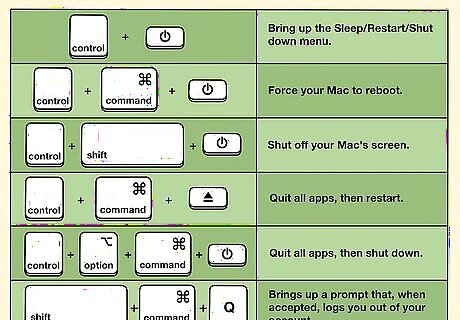
Make your computer sleep, log out, or shut down. There are several shortcuts you can use to lock down your computer quickly: Control + Power button - Bring up the Sleep/Restart/Shut down menu. Control+⌘ Command + Power button - Force your Mac to reboot. Control+⇧ Shift + Power button - Shut off your Mac's screen. Control+⌘ Command + Media eject button - Quit all apps, then restart. Control+⌥ Option+⌘ Command + Power button - Quit all apps, then shut down. ⇧ Shift+⌘ Command+Q - Brings up a prompt that, when accepted, logs you out of your account. ⌥ Option+⇧ Shift+⌘ Command+Q - Logs you out of your account without asking to confirm.
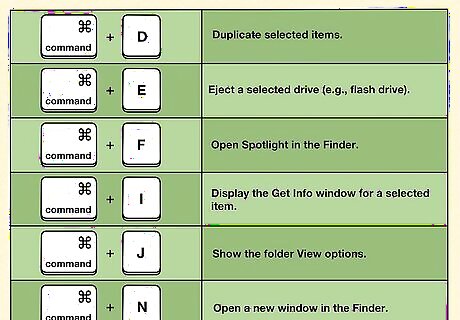
Use shortcuts to navigate the Finder. You can use keyboard shortcuts to perform several actions inside of the Finder: ⌘ Command+D - Duplicate selected items. ⌘ Command+E - Eject a selected drive (e.g., flash drive). ⌘ Command+F - Open Spotlight in the Finder. ⌘ Command+I - Display the Get Info window for a selected item. ⌘ Command+⇧ Shift+C - Open the Computer folder. ⌘ Command+⇧ Shift+D - Open the Desktop folder. ⌘ Command+⇧ Shift+F - Open the All My Files folder. ⌘ Command+⇧ Shift+G - Open a Go to Folder search. ⌘ Command+⇧ Shift+H - Open your Mac's Home folder. ⌘ Command+⇧ Shift+I - Open iCloud Drive. ⌘ Command+⇧ Shift+K - Open the Network window. ⌥ Option+⌘ Command+L - Open the Downloads folder. ⌘ Command+⇧ Shift+O - Open the Documents folder. ⌘ Command+⇧ Shift+R - Open the AirDrop utility. Control+⌘ Command+⇧ Shift+T - Place the selected item on the Dock. ⌘ Command+⇧ Shift+U - Open the Utilities folder. ⌘ Command+⌥ Option+D - Hide the Dock (or show it if it's already hidden). Control+⌘ Command+T - Add the selected item to the Finder sidebar. ⌥ Option+⌘ Command+P - Hide the address bar (or show it if it's hidden). ⌥ Option+⌘ Command+S - Hide the sidebar (or show it if it's hidden). ⌘ Command+J - Show the folder View options. ⌘ Command+N - Open a new window in the Finder. ⌘ Command+⇧ Shift+N - Create a new folder in your current location in the Finder. ⌘ Command+⌥ Option+N - Create a "smart" folder in your current location in Finder. ⌘ Command+⌥ Option+V - Move copied files from their current location to your current location. ⌘ Command + 1, 2, 3, or 4 - Change the way icons are displayed in the current folder. ⌘ Command+[ - See the last folder you were in. ⌘ Command+] - Go to the next folder in the path. ⌘ Command + Brightness down - Enable or disable display mirroring while your Mac is connected to another display (e.g., a TV). ⌘ Command+Del - Send a selected item to the Trash. ⌘ Command+⇧ Shift+Delete - Empty the Trash with a warning message. ⌘ Command+⌥ Option+⇧ Shift+Delete - Empty the trash without warning. ⌥ Option + Brightness up - Open the Display settings. ⌥ Option+Mission Control - Open your Mission Control preferences. ⌥ Option+Volume Up - Open your Mac's Sound preferences. ⌘ Command+Mission Control - Displays the desktop.
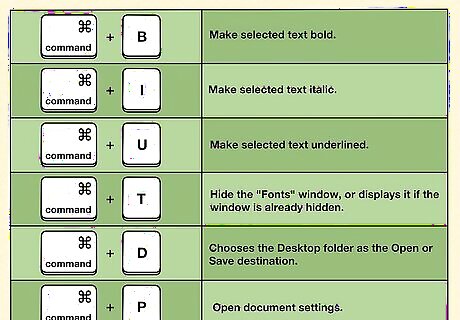
Use shortcuts to edit the text in a document. Rather than clicking a text editor's various buttons, you can use shortcuts to edit the text: ⌘ Command+B - Make selected text bold. ⌘ Command+I - Make selected text italic. ⌘ Command+U - Make selected text underlined. ⌘ Command+T - Hide the "Fonts" window, or displays it if the window is already hidden. ⌘ Command+D - Chooses the Desktop folder as the Open or Save destination. ⌘ Command+Control+D - Display a selected word's definition. ⌘ Command+⇧ Shift+: - See the "Spelling and Grammar" window. ⌘ Command+; - Search for spelling errors in the document. Control+L - Place the cursor in the center of the screen. ⌘ Command+⌥ Option+F - Open the Search field. ⌘ Command+⌥ Option+C - Copy selected text's formatting. ⌘ Command+⌥ Option+V - Apply copied formatting to selected text. ⌘ Command+⌥ Option+⇧ Shift+V - Apply formatting from surrounding content to selected content. ⌘ Command+I - Bring up the Inspector window. ⌘ Command+P - Open document settings. ⌘ Command+⇧ Shift+S - Open the "Save As" window. ⌘ Command+⇧ Shift+- - Decrease a selected item's font size (or picture size). ⌘ Command+⇧ Shift++ - Increase a selected item's font size (or picture size). ⌘ Command+⇧ Shift+? - Open the Help window.




















Comments
0 comment